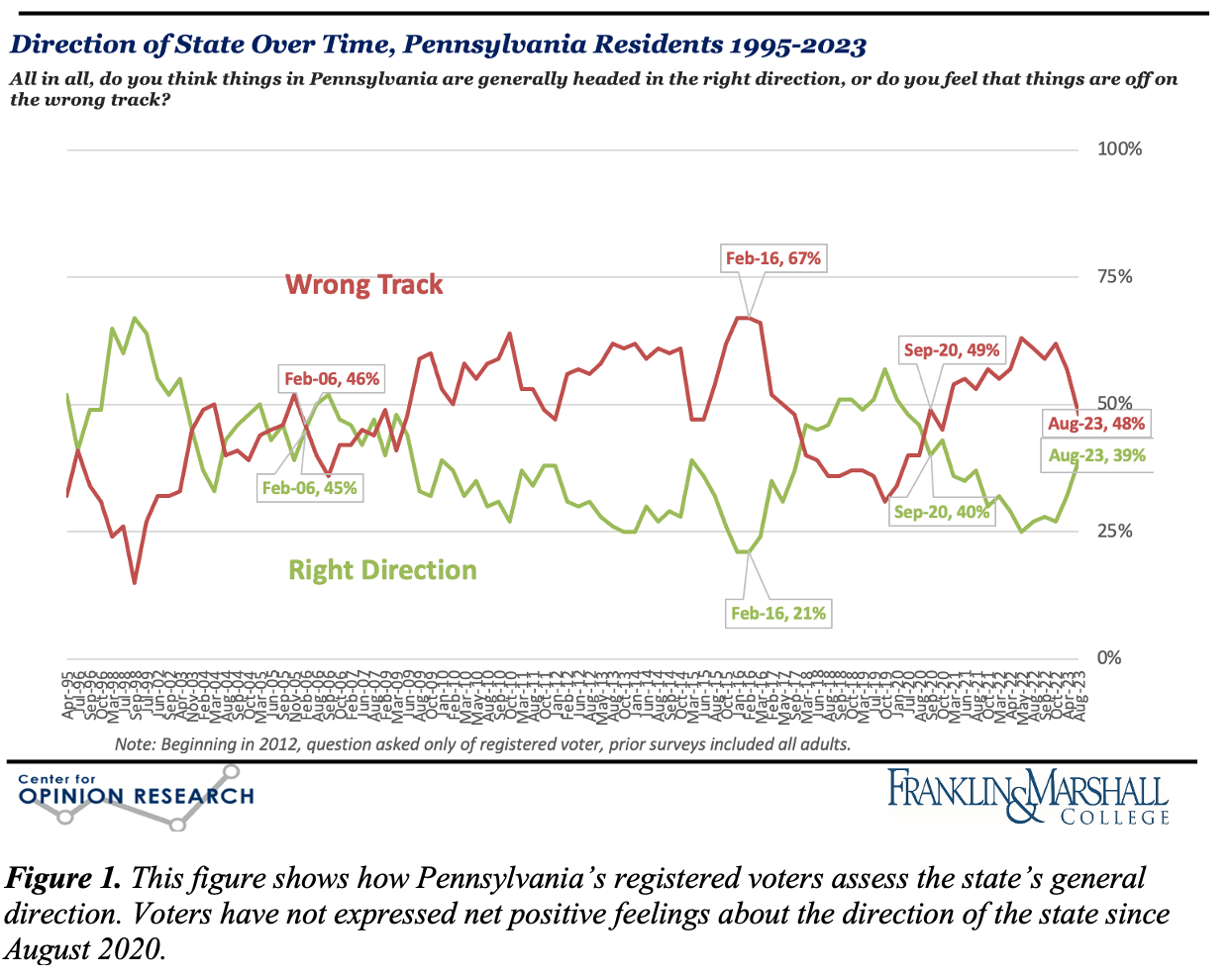Franklin & Marshall Poll Release: August 2023
This month's poll explores the Republican presidential primary race, the indictments of former President Trump, ratings of political figures, economic issues, and climate change.
Dear Readers,
I'm writing to share our summary report for the August 2023 Franklin & Marshall College Poll. I've highlighted a few of the key findings below, but I encourage you to read the full report, which is also included. The Poll explores the mood of the state's voters, their positions on issues like climate change, the indictments against former President Trump, and their ratings of state political figures, as well as Republicans' preferences in the presidential primary race.
Thank you for reading,
Berwood Yost
Key Findings
The August 2023 Franklin & Marshall College Poll finds that the state’s registered voters’ feelings about their personal finances are starting to improve, although many remain dissatisfied. About two in five (39%) respondents say they are “worse off” than a year ago, which is down from nearly half (46%) in April, and more say they are “better off” financially than they were last year (15% compared to 11%). Pennsylvania voters remain more pessimistic than optimistic about conditions in the state, but this sentiment has also improved--two in five (39%) registered voters believes the state is “headed in the right direction” which is higher than the one in three (32%) who felt that way in April. Concern about the economy (23%), including unemployment and higher gas and utility prices, continues as the most important and often mentioned problem facing the state.

Shapiro, Casey, and Biden Job Approval Ratings
Almost one in two (47%) registered voters believes Josh Shapiro is doing an “excellent” or “good” job as governor, which is higher than in April (43%). This is the highest approval rating for a governor at this point in his first term since Governor Ridge. The governor’s job approval rating increased despite the state budget impasse, perhaps because he was less likely to be blamed for the impasse than the legislature. One in five (20%) registered voters thought the missed budget deadline was mostly the governor’s responsibility, one in five (20%) blamed House Democrats, and one in three (32%) blamed Senate Republicans.

About one in three (31%) registered voters in Pennsylvania believes Bob Casey is doing an “excellent” or “good” job as their U.S. Senator. Senator Casey’s ratings are a bit lower than his ratings in October 2018, prior to his last election, when he had a 43% positive job approval rating, although they are the same as his ratings in August 2011 (32%), about one year prior to his first re-election campaign. Nearly one in five (19%) voters says they don’t know enough about the Senator to rate his performance.
About one in three (30%) registered voters in Pennsylvania believes President Biden is doing an “excellent” or “good” job as president, which is a slight improvement from his April ratings (27%). It is normal for an incumbent’s job approval ratings to start to increase at this point in their first term. President Biden’s current rating is lower than President Trump’s and President Obama’s ratings in Pennsylvania at the same point in their terms. Despite this, he still holds an advantage in a head-to-head matchup against the former president, 42% to 40%, although many voters are looking for an alternative to both candidates.
Republican Presidential Primary and Trump Indictment
President Trump leads the Republican primary field in Pennsylvania with an 18-point advantage over his closest rival, Florida Governor Ron DeSantis, 39% to 21%. Vivek Ramaswamy (9%) is currently in third place in the primary race. Mr. Trump’s advantage over Governor DeSantis has widened considerably since April, although his relative vote share has stayed consistent. The state’s registered voters do not have a favorable impression of the former President--he is viewed more unfavorably (64%) than favorably (34%) by the state’s voters. These ratings are lower now than they were prior to the 2020 election (40% favorable, 57% unfavorable in September 2020). Nearly three in five (58%) registered voters think that Mr. Trump’s attempt to remain in power after the 2020 election was a serious crime.

Methodology
The survey findings presented in this release are based on the results of interviews conducted August 9 – 20, 2023. The interviews were conducted at the Center for Opinion Research at Franklin & Marshall College. The data included in this release represent the responses of 723 registered Pennsylvania voters, including 324 Democrats, 297 Republicans, and 102 independents. The sample of voters was obtained from Aristotle. All sampled respondents were notified by mail about the survey. Interviews were completed over the phone and online depending on each respondent’s preference. Survey results were weighted (age, gender, education, geography, vote history, and party registration) using an iterative weighting algorithm to reflect the known distribution of those characteristics. Estimates for age, geography, and party registration are based on active voters within the PA Department of State’s voter registration data. Gender and education are estimated using data from the November 2022 CPS Voter Registration Supplement.
The sample error for this survey is +/- 4.5 percentage points when the design effects from weighting are considered. The sample error for questions based on subgroups is larger and is +/- 7.0 percentage points for the Republican presidential primary questions. In addition to sampling error, this poll is also subject to other sources of non-sampling error. Generally speaking, two sources of error concern researchers most. Non-response bias is created when selected participants either choose not to participate in the survey or are unavailable for interviewing. Response errors are the product of the question and answer process. Surveys that rely on self-reported behaviors and attitudes are susceptible to biases related to the way respondents process and respond to survey questions.
Franklin & Marshall College Poll Newsletter
Join the newsletter to receive the latest updates in your inbox.
